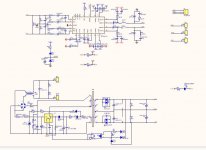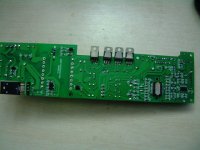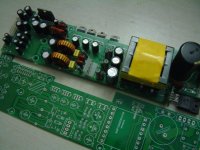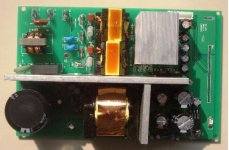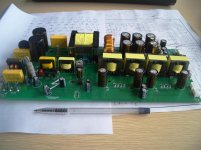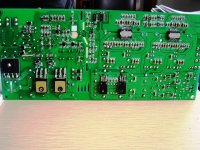TDA8920 TDA8924 By Connexelectronic, Opinions Please.
I recently asked http://connexelectronic.com/ if their class-D amplifiers were of a standard to be called audiophile quality, I received this reply:
"cirrus,
to answer to your question, i will quote from the amplifier module datasheets few charcteristics:
"ƒÞ cirrus,
to answer to your question, i will quote from the amplifier module datasheets few charcteristics:
"ƒÞ TDA8920: Output Power: 2x70W at 4£[, or 35W at 8£[, with max. 0.1% THD+N, at +/- 27V Supply Voltage.
ƒÞ TDA8924: Output Power: 2x70W at 4£[, or 35W at 8£[, with max. 0.1% THD+N, at +/-27V Supply Voltage.
ƒÞ Output Power in Bridge mode: 160W at 4£[, +/-24V or 135W at 8£[, +/-27V Supply Voltage.
ƒÞ Audiophile sound Quality: 0.02% THD+N at 36W at 4£[ or 20W at 8£[.
ƒÞ Very good efficiency: Up to 90% at 2x35W at 8£[ or up to 87% at 2x70W at 4£[.
"
i consider them audiophile quality, and i also built my own system whic i use for listening with this amplifiers.: Output Power: 2x70W at 4£[, or 35W at 8£[, with max. 0.1% THD+N, at +/- 27V Supply Voltage.
ƒÞ TDA8924: Output Power: 2x70W at 4£[, or 35W at 8£[, with max. 0.1% THD+N, at +/-27V Supply Voltage.
ƒÞ Output Power in Bridge mode: 160W at 4£[, +/-24V or 135W at 8£[, +/-27V Supply Voltage.
ƒÞ Audiophile sound Quality: 0.02% THD+N at 36W at 4£[ or 20W at 8£[.
ƒÞ Very good efficiency: Up to 90% at 2x35W at 8£[ or up to 87% at 2x70W at 4£[.
i consider them audiophile quality, and i also built my own system whic i use for listening with this amplifiers."
From the above specs what would you think about them say, compared with the Hypex modules? I know they are of a lot less power but don't mind that if they sound excellent. They are also a lot less expensive which is really a very good point in their favour.
I wonder if anyone who has one of these amplifiers would please share their experiences and also let us know how they rate the sound quality.
I recently asked http://connexelectronic.com/ if their class-D amplifiers were of a standard to be called audiophile quality, I received this reply:
"cirrus,
to answer to your question, i will quote from the amplifier module datasheets few charcteristics:
"ƒÞ cirrus,
to answer to your question, i will quote from the amplifier module datasheets few charcteristics:
"ƒÞ TDA8920: Output Power: 2x70W at 4£[, or 35W at 8£[, with max. 0.1% THD+N, at +/- 27V Supply Voltage.
ƒÞ TDA8924: Output Power: 2x70W at 4£[, or 35W at 8£[, with max. 0.1% THD+N, at +/-27V Supply Voltage.
ƒÞ Output Power in Bridge mode: 160W at 4£[, +/-24V or 135W at 8£[, +/-27V Supply Voltage.
ƒÞ Audiophile sound Quality: 0.02% THD+N at 36W at 4£[ or 20W at 8£[.
ƒÞ Very good efficiency: Up to 90% at 2x35W at 8£[ or up to 87% at 2x70W at 4£[.
"
i consider them audiophile quality, and i also built my own system whic i use for listening with this amplifiers.: Output Power: 2x70W at 4£[, or 35W at 8£[, with max. 0.1% THD+N, at +/- 27V Supply Voltage.
ƒÞ TDA8924: Output Power: 2x70W at 4£[, or 35W at 8£[, with max. 0.1% THD+N, at +/-27V Supply Voltage.
ƒÞ Output Power in Bridge mode: 160W at 4£[, +/-24V or 135W at 8£[, +/-27V Supply Voltage.
ƒÞ Audiophile sound Quality: 0.02% THD+N at 36W at 4£[ or 20W at 8£[.
ƒÞ Very good efficiency: Up to 90% at 2x35W at 8£[ or up to 87% at 2x70W at 4£[.
i consider them audiophile quality, and i also built my own system whic i use for listening with this amplifiers."
From the above specs what would you think about them say, compared with the Hypex modules? I know they are of a lot less power but don't mind that if they sound excellent. They are also a lot less expensive which is really a very good point in their favour.
I wonder if anyone who has one of these amplifiers would please share their experiences and also let us know how they rate the sound quality.
So anything below 0.02% THD is audiophile quality, then why tube amps with 1% THD are also audiphile's choice.........
I think a T-amp will do good here also, after all what you need is to know how to wire a volume control to it and it works like anything and we have moderator's support for it also.
I think a T-amp will do good here also, after all what you need is to know how to wire a volume control to it and it works like anything and we have moderator's support for it also.
classdphile said:Wow, do they know you go around pasting personal emails to public forums? That's totally uncool!
Still going round making snide remarks I see. You add nothing to this forum so WIND-YOUR-NECK-IN, get your facts right before opening your mouth in the future, see here: http://www.diyaudio.com/forums/showthread.php?postid=1740060#post1740060
cirrus18 said:
Still going round making snide remarks I see. You add nothing to this forum so WIND-YOUR-NECK-IN, get your facts right before opening your mouth in the future, see here: http://www.diyaudio.com/forums/showthread.php?postid=1740060#post1740060
My sincerest apologies, I hadn't realized it was just another case of cross posting and not citing the source you paste from.
http://www.diyaudio.com/forums/showthread.php?postid=1739968#post1739968
chill-out folks, the answer to the questions can be in the datasheet: http://www.connexelectronic.com/documents/TDA892x_Audio_Amplifier_Module.pdf
should i spam the board, like i saw in other places, saying that is the best module ever made, with 101% efficiency, cheapest possible or other subjective oppinions ?
i think the customers which purchased this before and use them can say their oppinions.
as Workhorse mentioned before, the "audiophile" term is absolutely relative, as some ppls preffer tubes, others Class A, other (including me) high efficiency of class D and T, without compromising the sound quality. it is not a Class D or T advertisment, since for now i sell at least as much Class AB amps as Class D and T together.
should i spam the board, like i saw in other places, saying that is the best module ever made, with 101% efficiency, cheapest possible or other subjective oppinions ?
i think the customers which purchased this before and use them can say their oppinions.
as Workhorse mentioned before, the "audiophile" term is absolutely relative, as some ppls preffer tubes, others Class A, other (including me) high efficiency of class D and T, without compromising the sound quality. it is not a Class D or T advertisment, since for now i sell at least as much Class AB amps as Class D and T together.
Hi,
First post in diyaudio, seems very very interesting to me what is discussed here !
I'm working on a self amplified speaker dedicated to bass frequencies, and the TDA8920 et TDA8924 seem to fit all my needs : enough power, very good efficiency, small size, bridgeable, and very well priced
As I don't know these chips at all (I'm more in Tripath at the moment), I still have a few questions :
- why should you prefer one chip or the other ? They seem to have the same specs, where is the difference ?
- I understand the heatsink has to be placed on the base of the IC. Would a flat metal piece be sufficient if large enough ? (I have casing issues ...)
- cnx, do you provide a facility to operate the mode ? I'm not very self-confident in electronic details, and I have difficulties understanding all the stuff provided in the user manual (would be better translated in French )
)
Thanks for you answers !
First post in diyaudio, seems very very interesting to me what is discussed here !
I'm working on a self amplified speaker dedicated to bass frequencies, and the TDA8920 et TDA8924 seem to fit all my needs : enough power, very good efficiency, small size, bridgeable, and very well priced
As I don't know these chips at all (I'm more in Tripath at the moment), I still have a few questions :
- why should you prefer one chip or the other ? They seem to have the same specs, where is the difference ?
- I understand the heatsink has to be placed on the base of the IC. Would a flat metal piece be sufficient if large enough ? (I have casing issues ...)
- cnx, do you provide a facility to operate the mode ? I'm not very self-confident in electronic details, and I have difficulties understanding all the stuff provided in the user manual (would be better translated in French
Thanks for you answers !
the main difference between this 2 IC is the output power, output load impedance and the sound quality. although in the datasheet is stated that they have same supply voltage and similar output power at low THD, TDA8924 can work with low impedances such as 2ohm and TDA8920 can work with at least 4ohm. the current limit also is 7.5-8A for 8920 and 11-12A for 8924. the sound quality is a little better for 8920 than 8924, esspecially if is 8920B.
for cooling, is enough to install on a flat surface, which can provide less than 5 deg/W thermal resistance. note that the thermal pad need to be insulated from the GND, as is connected to V-, not GND.
for cooling, is enough to install on a flat surface, which can provide less than 5 deg/W thermal resistance. note that the thermal pad need to be insulated from the GND, as is connected to V-, not GND.
Hi,
I got 2 of these modules (purchased with Col) and just wired one up into an enclosure (a cheap "makeup" case from a discount shop) a few days ago.
I'm using it right now mainly with an Alien DAC (or the TV) and an passive attenuator/input switcher (Wanfai Lau ebay kit).. so no op amps, pre amps etc between the PCM2702 DAC and the TDA8920 power amp. Speakers are Alesis Monitor Ones., - also tried with JPW Sonatas (entry level English bookshelf speakers).
So far it sounds great, and I like how it runs cool with low power use compared to my ART SLA-1 Class B power amp.
There is definately a different sound between the 2 amps but I'm hard pressed to say which is better.
Using the Alien Dac there is a bit of noise(sizzle), but only noticable if I put my head next to the speakers when silent, its not audible away from the speakers. Using a NAD 5420 cd player (and some other sources) this low noise goes away, I guess its as I am using a fairly quiet source powered from PC straight into an all passive, non buffering "pre-amp", which also has other noisy devices (plasma TV, cheap DVD player) plugged into the other inputs.
So far this is a win.. due to the low power usage. My Jaycar power meter shows it using 0 watts when silent and 5 watts at medium volume.. compared to the ART SLA-1which is more silent electrically but has a cooling fan (noise) and uses 25W when silent.
Once I get a good pic I'll put a pic of my cheapster enclosure in the Class D picture thread.
I got 2 of these modules (purchased with Col) and just wired one up into an enclosure (a cheap "makeup" case from a discount shop) a few days ago.
I'm using it right now mainly with an Alien DAC (or the TV) and an passive attenuator/input switcher (Wanfai Lau ebay kit).. so no op amps, pre amps etc between the PCM2702 DAC and the TDA8920 power amp. Speakers are Alesis Monitor Ones., - also tried with JPW Sonatas (entry level English bookshelf speakers).
So far it sounds great, and I like how it runs cool with low power use compared to my ART SLA-1 Class B power amp.
There is definately a different sound between the 2 amps but I'm hard pressed to say which is better.
Using the Alien Dac there is a bit of noise(sizzle), but only noticable if I put my head next to the speakers when silent, its not audible away from the speakers. Using a NAD 5420 cd player (and some other sources) this low noise goes away, I guess its as I am using a fairly quiet source powered from PC straight into an all passive, non buffering "pre-amp", which also has other noisy devices (plasma TV, cheap DVD player) plugged into the other inputs.
So far this is a win.. due to the low power usage. My Jaycar power meter shows it using 0 watts when silent and 5 watts at medium volume.. compared to the ART SLA-1which is more silent electrically but has a cooling fan (noise) and uses 25W when silent.
Once I get a good pic I'll put a pic of my cheapster enclosure in the Class D picture thread.
Hi,
Once I get a good pic I'll put a pic of my cheapster enclosure in the Class D picture thread.
done.. pictures added.
just a further update, after various experiments with different grounding schemes with my Connex TDA8920, I found it was dead quiet disconnecting mains ground. Of course this is not safe long term so I have implemented the ground loop breaker circuit as described here: on Cols suggestion and now the amp is VERY quiet.
On continued listening (still using Alesis Monitor One speakers) I'll class this now as audiophile grade for sure.
On continued listening (still using Alesis Monitor One speakers) I'll class this now as audiophile grade for sure.
TDA892x Amp V2
I recently received a V2 board, quite a bit smaller. Iv'e got it into an temporary enclosure made from a PC PSU. It's also dead quite and sounds great.
TDA892x Amp V2
col.
I recently received a V2 board, quite a bit smaller. Iv'e got it into an temporary enclosure made from a PC PSU. It's also dead quite and sounds great.
TDA892x Amp V2
col.
8950th
I have bought 10 pcs of 8950TH v2 boards. I will use 2 boards for my main setup, and probably 2 a second setup.
The rest will be bought from other. The project will be posted on HIFI4ALL.DK | Magasin om HiFi, Hi-Fi, Surround Sound og Audio Video but thats in danish. I will also give feedback here.
I have bought 10 pcs of 8950TH v2 boards. I will use 2 boards for my main setup, and probably 2 a second setup.
The rest will be bought from other. The project will be posted on HIFI4ALL.DK | Magasin om HiFi, Hi-Fi, Surround Sound og Audio Video but thats in danish. I will also give feedback here.
I also made amp and SMPS module for TDA8950.schematic here ,If anybody like ,please do it youself.If you have any question please ask me by mail.I have made lots of modules use tda8922 tda8920BTH TDA8950B,now NXP new class d chip TDA8953.TDA8954,high power out.but I still no time try it.
Attachments
Last edited:
I have compare many times,tda8920BJ sound better than tda8920bth,but tda8920bj difficult fit together.
Must careful if you add smps and tda8920 in one board,there always have hiss noise background.you must separate AGND and PGND .
few years ago ,I use TOP261YN and tda8920BTH design one module for combo powered mixer,it waste me lots of time to deal with this problem。I design 4 version PCB ,I work this out at last.
Must careful if you add smps and tda8920 in one board,there always have hiss noise background.you must separate AGND and PGND .
few years ago ,I use TOP261YN and tda8920BTH design one module for combo powered mixer,it waste me lots of time to deal with this problem。I design 4 version PCB ,I work this out at last.
Attachments
Now I get TDA8954 ,It's more powerful,TI TAS5630 deliver out 2*300W/4Ω,this chip can deliver out 2*210w/4Ω.
Specification:
SE 2 × 210 W, RL = 4 Ω (VDD = 41 V; VSS = −41 V)
SE 2 × 235 W, RL = 3 Ω (VDD = 39 V; VSS = −39 V)
SE 2 × 150 W, RL = 6 Ω (VDD = 41 V; VSS = −41 V)
BTL 1 × 420 W, RL = 8 Ω (VDD = 41 V; VSS = −41 V)
High output power in typical applications:
Symmetrical operating supply voltage range from
Stereo full differential inputs, can be used
as stereo SE or mono BTL amplifier
Low noise
Smooth pop noise-free start-up and switch off
2-pin diagnostics for protection circuits
Fixed frequency internal or external clock
High efficiency 93 %
Zero dead time switching
Low quiescent current
Advanced protection strategy: voltage protection and output current limiting
Thermal FoldBack (TFB) with disable functionality
Fixed gain of 30dB in SE and 36dB in BTL applications
Fully short-circuit proof across load
BD modulation in BTL configuration
Clock protection
Specification:
SE 2 × 210 W, RL = 4 Ω (VDD = 41 V; VSS = −41 V)
SE 2 × 235 W, RL = 3 Ω (VDD = 39 V; VSS = −39 V)
SE 2 × 150 W, RL = 6 Ω (VDD = 41 V; VSS = −41 V)
BTL 1 × 420 W, RL = 8 Ω (VDD = 41 V; VSS = −41 V)
High output power in typical applications:
Symmetrical operating supply voltage range from
Stereo full differential inputs, can be used
as stereo SE or mono BTL amplifier
Low noise
Smooth pop noise-free start-up and switch off
2-pin diagnostics for protection circuits
Fixed frequency internal or external clock
High efficiency 93 %
Zero dead time switching
Low quiescent current
Advanced protection strategy: voltage protection and output current limiting
Thermal FoldBack (TFB) with disable functionality
Fixed gain of 30dB in SE and 36dB in BTL applications
Fully short-circuit proof across load
BD modulation in BTL configuration
Clock protection
- Status
- This old topic is closed. If you want to reopen this topic, contact a moderator using the "Report Post" button.
- Home
- Amplifiers
- Class D
- TDA8920 TDA8924 By Connexelectronic, Opinions Please.
